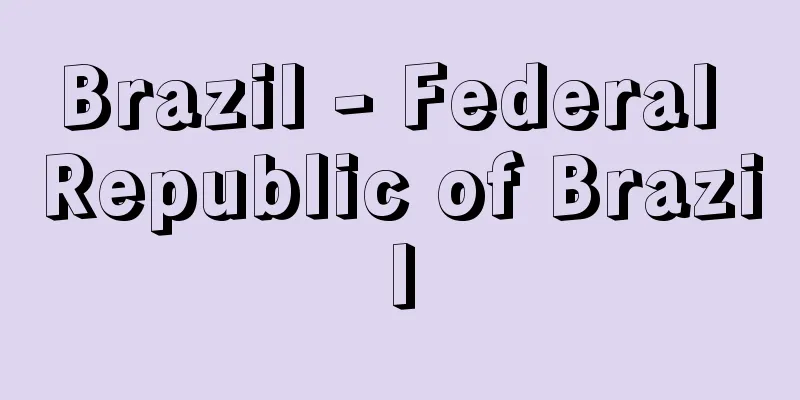Brazil - Federal Republic of Brazil

OverviewA federal republic in the center of South America. Its official name is República Federativa do Brasil, or the Federative Republic of Brazil. The name Brazil comes from the pau Brasil (meaning "flame-red wood" in Portuguese), which was once a speciality of the country and from which red dye was extracted. It borders Venezuela, Guyana, Suriname, and French Guiana to the north, Colombia and Peru to the west, Bolivia, Paraguay, Argentina, and Uruguay to the south, and faces the Atlantic Ocean to the east. Its area of 8,514,877 square kilometers makes it the fifth largest in the world after Russia, Canada, China, and the United States, and about 23 times the size of Japan. Its population is 169,799,170 (2000 census), and 186,771,000 (2006 estimate). Although it is the largest in Latin America, its population density is low at 22 people per square kilometer. The capital is Brasilia, which was moved from the former capital Rio de Janeiro in April 1960. It is located on a plateau at an altitude of 1,100 meters in the center of the Brazilian highlands, about 1,000 kilometers inland from the Atlantic coast. It is the only country in Latin America that developed from a Portuguese colony, and is famous as a coffee-producing country, but it is also one of the most industrially developed countries in Latin America. Although it is exactly on the other side of the world from Japan, it is the largest destination for Japanese immigrants, with a total population of about 1.5 million Japanese people (2008), 70% of whom live in the state of São Paulo. [Shozo Yamamoto] Nature and GeographyNatureThe country occupies 47.3% of the South American continent, stretching 4,320 km north to south and 4,380 km east to west from 5 degrees north to 34 degrees south. Most of it is tropical, with only 7% of its area south of the Tropic of Capricorn. Most of the country is plains, with the exception of the Guiana Highlands along the northern border and the mountain range that stretches north to south along the eastern coast, and the highest peak, Mount Bandeira, is only 2,890 meters above sea level. Half of the vast territory is included in the Amazon River basin. The coastline facing the Atlantic Ocean is extremely monotonous. The straight-line distance from the western edge of the country to the Pacific coast is not very great. Part of the western border borders the foothills of the Andes. The Amazon River is the largest river in Latin America, and covers most of the Brazilian territory. It originates in the Peruvian Andes, flows through northern Brazil, and empties into the Atlantic Ocean just below the equator. It is 6,300 km long, and its drainage area is 6.5 million square kilometers, the largest in the world, of which about 3,000 km, or 4.78 million square kilometers, is within Brazilian territory, accounting for 56% of the Brazilian landmass. There are six tributaries over 2,000 km long, and numerous waterfalls contain vast energy resources. Belém, located near the mouth of the river, is the largest port for distributing goods in the Amazon River basin, and Manaus, located near the confluence of the Amazon River and the Negro River, is the largest port in the Amazon Basin. During flood season (October to January, March to July), 3,000-ton ships can travel from the mouth of the river to Manaus, and 1,000-ton ships can travel to Iquitos. The difference in water levels between high and low water periods reaches 10.8 metres in Manaus. Brazil's geology includes Archean granite and granite gneiss, as well as the newest alluvial deposits. The oldest granites are distributed in the Guiana Highlands and the Brazilian Plateau. Palaeozoic and Mesozoic deposits have developed over these. Tertiary deposits are distributed widely in the Amazon basin and are deposited almost horizontally. Pleistocene and alluvial deposits have also developed along the Amazon River, but their distribution is limited. Both metallic and non-metallic deposits are found in older rocks up to the Mesozoic layer, but oil deposits have been confirmed in Tertiary deposits, especially those on the Atlantic coast and in the Amazon, and development is underway. [Shozo Yamamoto] GeographyThe vast territory of the country is divided into six regions, the North, Northeast, East, São Paulo, South, and Central-West, based on differences in natural conditions. The North is a vast lowland created by the Amazon River, which has 200 tributaries and a delta 335 km wide. It has a tropical climate with an annual rainfall of 2,000 mm and a temperature of around 30°C all year round, and the area is covered in jungle. There are more than 4,000 tree species, including giant trees that reach 50 meters in height, and the ecology of a typical tropical rainforest divided into several layers. The animals include the caiman crocodile, the anaconda snake, the beautiful morpho butterfly insects, and the piranha and arapaima fish, but in general there are many types of birds and insects, and few large mammals. The soil is mostly red soil called laterite, but in the southern part of the region, fertile dark purple terra rossa is widely distributed. Although the country is blessed with natural resources, including oil, uranium ore, and other minerals, development has lagged behind, with the only industry being rubber cultivation, which continues on a small scale. The indigenous people (Indians) are scattered throughout the region and live fairly isolated lives. Although they make up 42.7% of the national land area, they account for only 3% of the population. The central-northern part of the region consists of the states of Maranhão and Piauí, which are separated by the 1,200-kilometer-long Parnaiba River, and lies between the "drought polygon" regions of the northern and northeastern regions, and so combines the natural characteristics of both regions. The northeastern region is divided into a humid coastal plain and a dry inland plateau. The former is a narrow area along the coastline blessed with fertile soil, while the latter forms a semi-desert plain called "sertão." The coastal plain is a narrow rainy zone stretching from Salvador to Natal, and has been cultivated for farming and livestock farming. It was the region that was colonized the earliest, and many Africans were brought in as black slaves, leading to the active cultivation of sugarcane. Sugarcane is still produced today. In the depths of the inland plateau, a thorny cactus shrub called caatinga grows, and is mainly used for grazing. The states of Maranhão and Piauí, which lie on either side of the Parnaiba River, are transitional zones from the Amazon rainforest, and palm trees grow naturally there. Reflecting the region's history of development, 28% of the total population lives in the northeastern region, but the economic situation of the residents is poor. The main cities along the coast from north to south are Fortaleza, Natal, João Pessoa, and Recife. The Oriental Region is located in the eastern part of the Brazilian Highlands, and is centered on the states of Bahia, Minas Gerais, and Rio de Janeiro. The topography is complex, with a mountain range with the highest peak in the Brazilian Highlands, Mt. Bandeira, running north to south near the coast, and the São Francisco River flowing from south to north behind it. Just behind the coastal plain, a large cliff with an altitude of 800 meters rises like a wall. The coastal area is blessed with rainfall, but the inland area is a savanna called Campo Cerrado. Blessed with rich mineral resources such as oil near Salvador in Bahia, iron from the Itabira iron mine near Belo Horizonte in Minas Gerais, and electricity resources produced by the Paulo Afonso power plant, this region has a relatively developed industry. There are many livestock farming areas in the inland state of Minas Gerais. Although it only accounts for one-tenth of the country's land area, the inhabitants account for 43% of the total population. The São Paulo region was a frontier region during the Gold Rush of the 18th century, but today it is the core region of Brazil as a major coffee producing region and an industrial center. As coffee cultivation has become depleted due to the soil's fertility, people have stopped cultivating it and are moving inland in search of terra rossa areas. After cultivation has ceased, the area has become a place of regenerated forests and pastures. Santos is the world's leading coffee export port. São Paulo is Brazil's largest city and, together with Rio de Janeiro, forms the largest industrial area. Many foreign companies, including those from Japan, have established operations there, and the main industries are diverse, including textiles, chemicals, pharmaceuticals, electrical equipment, rubber, and machinery, producing more than one-third of Brazil's total industrial production. The topography of the southern region is similar to that of São Paulo state, but the temperature is lower, and the southern limit of coffee cultivation is in the northern part of Paraná state. Livestock farming and grain cultivation are thriving from southern Paraná state to Rio Grande do Sul state. There is no notable industry, but many of the rivers that flow into the Paraná River have great potential for power generation, and development is underway. Porto Alegre, located at the mouth of the Guaiba River, has fertile agricultural areas in its hinterland and is the largest commercial center south of São Paulo. A railway line connects to Uruguay from Santa Maria inland. The central-western region, which includes the capital city of Brasilia, includes gently undulating highland areas such as the Central Plateau, and the 120,000 square kilometres of Tacualli wetlands along the border with Bolivia. The northern part is covered by the tropical rainforests of the Amazon basin, while the southern part is covered by savanna. There are high hopes for the development of mineral resources, but most of the region remains undeveloped and sparsely populated. [Shozo Yamamoto] historyTrends of the timesBrazil was "discovered" and acquired by Portugal in 1500, eight years after Columbus' "discovery of the New World." Looking at the following political developments over the next 500 years, the country followed the following path. The colonial period was from 1530 to 1822 (however, from 1580 to 1640, the country was effectively under Spanish rule due to a "personal union" in which the King of Spain also served as King of Portugal. From 1815 to 1822, the country became part of the "United Kingdom of Portugal, Brazil and the Algarve" when the Portuguese royal family moved to Rio de Janeiro in 1808), the imperial period was from 1822 to 1889, and since 1889, the modern era has been based on a republic. Of these, 1889 to 1930 was the First Republic, 1930 to 1945 was the Vargas government, 1945 to 1964 was the era of populism, 1964 to 1985 was a military regime, and since 1985, the country has been in the process of consolidating democracy. In the case of Brazil, some consider the rise and fall of each of the major primary products supplied to the colonial power Portugal and the European and American markets to be one cycle (era), and trace the country's history through the change in major industries. The start and end of each cycle differ slightly depending on the scholar and source, but it began with the Pau Brasil cycle (first half of the 16th century), which was wood from which red dye could be extracted, followed by sugar (1530s-1670s), gold (late 17th century-1760s), coffee (1830s-1930s), and industry (1930s and after). There were also short-lived boom cycles in cotton cultivation, livestock farming, tobacco, and rubber. The shift in cycle is important not only for the change in industry, but also for the fact that it signified a shift south from the development frontier of the northeastern region to the southeastern region, making it important for considering the history of Brazil. [Kotaro Horisaka] "Discovery" and the colonial periodBrazil was "discovered" on April 22, 1500, by Portugal's Second Indies Expeditionary Fleet (commanded by Pedro Álvares Cabral), following Vasco da Gama. This happened at a time when other countries, led by Portugal and Spain, were competing to make "geographical discoveries." While some still believe that the "discovery" was a coincidence, there is also a strong view that the "discovery" of a fleet of 13 sailing ships crossing the Atlantic was a deliberate act to establish sovereignty over the country. The fleet's dock (Porto Seguro) was within the exclusive territory of Portugal that had been established between Portugal and Spain in the Treaty of Tordesillas in 1494. The indigenous Indian society was an integrated tribal society that combined hunting and gathering economy with slash-and-burn agriculture, and was very different from the Incas, who had reached the state level in the Andes, and even from chiefdom-level societies. The population was relatively small, and the presence of the Indians during colonial rule was very different from that of South American countries along the Pacific coast, such as Peru. Portugal's colonization of Brazil began in earnest after the 1530s, when the sugar industry was introduced. Until then, they had been busy trading with Asia, and had only cut down and transported the Pau Brasil trees that grew wild along the Atlantic coast. The prosperity of the sugar industry was due to a combination of the tropical climate and fertile soil of northeastern Brazil, the Portuguese royal land distribution system that laid the foundation for large landownership, sugar cane and plantation cultivation methods introduced from the Madeira Islands in the Atlantic, black slaves brought from Africa, and strong demand for sugar in the European market and Dutch financial capital. In the second quarter of the 17th century, northeastern Brazil was subject to repeated invasions by the Dutch. Spain, which had de facto control over Brazil through its "personal union" with Portugal, excluded the Dutch from the sugar-producing region of northeastern Brazil, which had become the world's largest. The Dutch withdrew in 1654, but when they left, they brought sugar-producing technology with them and transplanted it to the Caribbean islands. This made them powerful rivals, and the sugar cycle went into a period of decline (currently, Brazil is the world's leading sugar producer). The colonial period was also a time of exploration into the interior. In addition to geographical interests, the aim was to discover precious metals and capture Indians for slave labor, and the "Personal Union" made it easier to encroach on Spanish territory. It was an important catalyst for the formation of the present-day Brazilian territory, which expanded far westward beyond the borders established by the Treaty of Tordesillas. At the end of the 17th century, the long-awaited gold was discovered. The highlands in southeastern Brazil (today's Minas Gerais), where gold was mined, were abuzz with the gold rush, including refugees from overseas, and a mule caravan linked the various colonies. The royal family established mints and strengthened taxation, and the gold transported to the home country enriched the national treasury, and then flowed to Britain, which was in the midst of the Industrial Revolution. This was a time when resistance against Portugal increased within the colonies. [Kotaro Horisaka] Transfer of the royal family and the EmpireIn March 1808, the Portuguese royal family was pursued by the French army of Napoleon, and was protected by the British fleet as they crossed the Atlantic and relocated to the colony of Rio de Janeiro in Brazil. This was a flight after they had been caught up in the struggle for hegemony between Britain and France. With the relocation of the capital, the country opened its ports to foreign countries, which had been strictly prohibited under mercantilist policies, and printing, newspaper publishing, the establishment of factories and higher education institutions, and the improvement of the capital's environment progressed. This meant the virtual collapse of the colonial system, but the treaty that was concluded was an unequal one, granting extraterritoriality to Britain and granting British products more favorable tariffs than Portuguese products. Brazil's independence was achieved when King João VI returned to his home country and the remaining princes declared independence (September 7, 1822). Brazil became a constitutional monarchy, and was South America's only empire for 67 years, with two kings (Dom Pedro I and Dom Pedro II) and a regency between them. Some point out that the reason Brazil was able to maintain its unity while Spanish colonies separated into numerous republics was due to the existence of the empire. The 19th century was also a time when coffee flourished as a major export product. The main production areas shifted to Rio de Janeiro and São Paulo in the southeast. In the mid-19th century, coffee beans accounted for 50% of exports, and railways were built to transport them and European immigrants were brought in as labor. On the other hand, slavery was also a problem, and under pressure from Britain, the import of slaves was banned (1850) and abolished (1888). [Kotaro Horisaka] The First Republic and the Vargas GovernmentA military uprising led to the transition to a republic in November 1889. The background to the collapse of the empire is said to be the growing influence of military men with republican ideology following the victory in the Paraguayan War (1864-1870), the loss of support from plantation owners due to the abolition of slavery, and discord with the Catholic Church, with which the empire had a mutually dependent relationship. In 1891, the first republican constitution was enacted, modelled on the US system and based on the pillars of federalism, separation of powers and a presidential system. However, in reality it was an oligarchy that strongly reflected the wishes of the landlord class in the states of São Paulo and Minas Gerais, the largest coffee producing states. To distinguish it from subsequent republics, it is called the "First Republic" or "Old Republic". With the influx of free immigrants from Europe, the Middle East and Japan (Japan began in 1908), this was a time when the bipolar society of the colonial era, based on the landlord class and slave class, began to change dramatically. The seeds of nationalism were also seen, partly due to the influence of World War I. In November 1930, amid the decline of the coffee economy caused by the Great Depression and oligarchy turmoil surrounding the presidential election, the president was forced to resign under pressure from the military, and Getúlio Vargas, the governor of Rio Grande do Sul who had lost the election, was handed over to the presidency by a young military officer. Although there was no change in the class structure, this is called the "Vargas Revolution" and is considered an important turning point in the history of Brazilian development. President Vargas remained in power for 15 years until the end of World War II in October 1945. During this time, he became increasingly dictatorial, serving as head of a provisional government, president indirectly elected under the 1934 Constitution, and president under the totalitarian "New National Regime." He shifted the country's politics from the decentralized style of government seen up until the First Republic, which included sending consuls to the states, to a more centralized style, and he shifted the country's course from an export economy to one of import substitution industrialization, which promoted domestic industrialization by restricting the import of industrial products through domestic production of steel, chemical fertilizers, and other products. He created a nationalist system of unions between workers and employers, and just before he resigned, he founded the first national political parties in history, the Social Democratic Party (PSD) and the Brazilian Labor Party (PTB), leaving a significant mark on Brazilian politics. In foreign relations, he was initially in favor of the Axis powers, such as Germany and Italy, but with the encouragement of the United States, he joined the Second World War on the side of the Allies and sent troops to the Italian front. [Kotaro Horisaka] Postwar populism and military ruleAfter World War II, five presidents elected by direct popular vote ruled the country until the military coup that took place between the early hours of March 31st and April 1st, 1964. While the system was democratic, it was an era marked by populism, with the president directly reaching out to the people. Of the five presidents, President Vargas, who returned to power after the war, committed suicide, the fourth president, President Quadros, resigned eight months into his term, and the fifth president, President Goulart, was ousted in a coup, resulting in a turbulent country with a divide between the left and right. However, during the postwar third term under President Kubitschek, under the slogan "50 years of delay in five years," infrastructure such as roads and power networks were developed, industrialization progressed in the fields of automobiles, shipbuilding, steel, and more, and the capital was moved from Rio de Janeiro to Brasilia, a highland city 960 kilometers inland. As a driver of industry, state-run enterprises were nurtured and foreign capital was actively introduced. The military era lasted for a long period of 21 years until the transfer of power to a civilian government on March 15, 1985, and was considered a typical example of an authoritarian regime backed by the power of the military. While maintaining the appearance of a state governed by law through the implementation of supra-constitutional military decrees, the establishment of a new constitution, and the use of presidential decrees, the military exerted control over politics in general by spreading intelligence agencies like a spider's web, purging opposition forces from public office, repeatedly closing down the National Assembly, and thoroughly suppressing student movements and urban guerrilla movements. Existing political parties were dissolved, and the government organized the ruling and opposition parties, the National Renewal Alliance (ARENA) and the Brazilian Democratic Movement (MDB). After the period of military rule from 1964 to 1968, the period of establishment could be considered the period from 1969 to 1977. During this period, Brazil achieved high growth of over 10% per year from 1968 to 1973, which was called the "Brazilian Miracle". Throughout the period of military rule, import substitution industrialization of durable consumer goods and capital goods progressed, laying the foundations for the newly industrialized economies (NIES). The oil crisis of 1973 also prompted the use of ethanol as a gasoline substitute and the start of oil exploration on the continental shelf. On the other hand, external borrowing from international financial markets increased, and at the end of 1982, Brazil requested assistance from developed countries and international organizations for its debt crisis (external debt crisis). [Kotaro Horisaka] Towards a transition to civilian rule and the consolidation of democracyThe transfer of power to a civilian government in March 1985 was carried out peacefully. The military's fourth president pledged to "ease tensions," while the fifth president pledged to "political opening," and the process was carried out despite many twists and turns. Prior to the transfer, the presidential election in January 1985 was an indirect military-style election, but opposition politician Tancredo Neves was elected. Neves collapsed just before the new government was to be inaugurated, and died one month later, but the military leaders did not change their stance on the transfer of power. The first three civilian governments (Presidents Sarnay from 1985 to 1990, Collor from 1990 to 1992, and Franco from 1992 to 1994) were busy dealing with a complex economic crisis that began with the foreign debt crisis of 1982. Drastic economic policies such as price freezes were repeatedly adopted to curb inflation, which had reached triple and quadruple digit annual rates, but no improvement was seen. Economic stability was finally achieved with orthodox economic policies led by Finance Minister Cardoso (next president), who introduced the new currency, the real, in July 1994. Debt reduction negotiations with creditor banks and creditor government agencies were also extremely difficult, but an agreement was reached in 1992 to postpone repayments and securitize the debt. Under the Sarnay administration, relations with neighboring Argentina grew closer, which led to the 1995 Paraguay The two presidents who followed, Cardoso (in office 1995-2002) and Lula (Luiz Inacio Lula da Silva, in office 2003-2010), both served two terms and led stable governments following a national referendum (1997) that allowed consecutive reelections. The Cardoso administration worked to improve the country's economic structure, including administrative and financial reforms, privatizing state-run enterprises, improving state finances through the Fiscal Responsibility Law, and shifting to a floating exchange rate system in the wake of the 1999 currency crisis. These measures improved the ability of the Brazilian economy to respond to the global economic crisis in 2008. While the Lula administration inherited the policies of the Cardoso administration in principle, it sought to boost domestic consumption by raising the minimum wage and implementing a cash benefit system for low-income earners. With the start of the 21st century, in response to growing global demand for food, resources, and energy, particularly from China, the country has once again attracted global attention as a supplier of primary commodities, including soybeans, sugar, and meat, minerals such as iron ore, and energy such as ethanol. [Kotaro Horisaka] PoliticsPolitical systemBrazil is a federal republic consisting of 26 states and the Federal District of Brasilia, the capital. Although a system of separation of legislative, executive, and judicial powers has been established, the president, who is the head of state, is given broad powers as the country is a presidential system in which the president also serves as the head of the executive branch. On the other hand, the political power of the states is quite strong, as can be seen from the fact that the country was called the "United States of Brazil" from the founding of the republic in 1891 until 1967 under the military regime. The country is divided into five regions. The northeast, which developed during the colonial period and has a strong traditional character, is made up of nine states, the southeast, which is the economic center including São Paulo and Rio de Janeiro, is made up of four states, the southern agricultural production area is made up of three states, the inland midwest is an agricultural and livestock frontier with four states, and the northern six states are made up of the Amazon rainforest. The capital, Brasilia, is located in the midwest. Lower-level municipalities are called municipalities. There is a large difference in size, from municipalities with populations of several million to several thousand, such as São Paulo, and it is better to think of them as equivalent to the individual cities and towns of Japan depending on their size. As of 2008, there were 5,565 municipalities nationwide. The current constitution is the democratic constitution of 1988, which was promulgated three and a half years after the transfer of power from a military government to a civilian government. It is the eighth constitution since the Imperial Constitution of 1824 during the imperial era. Compared to the 1967 constitution (revised in 1969) during the military era, it significantly expanded the rights of citizens. Even after its promulgation, the constitution has been repeatedly debated and revised in the National Assembly in order to revise its provisions to reflect reality. [Kotaro Horisaka] Elections and political partiesSince the transfer of power to civilian rule in 1985, all elections have been directly elected by the people, compulsory for those between the ages of 18 and 69, and optional for those between 16 and 17 and those over 70. Terms of office for public officials are four years for two terms for the president, state governors, and mayors (heads of municipalities). Senators representing each state (3 from each state, a total of 81 seats) serve eight-year terms, while members of the House of Representatives (513 seats), state legislators (unicameral), and city council members (same) serve four-year terms and are elected using an open-list proportional representation system. There are no restrictions on re-election for any of them. Elections for the president, both houses of parliament, state governors and state legislators are held simultaneously on the first Sunday in October of the same year, so the impact of these elections on the political world is great. If there is no winner in the mayoral election, a runoff election is held between the top two candidates. Elections for mayors and city council members are held in mid-year. After two consecutive terms of stable administrations under President Fernando Henrique Cardoso (1995-2002) and President Luiz Inacio Lula da Silva (Lula) (2003-2010), elections were held in October 2010. The government was inaugurated the following January 2011. The changes in political parties have been remarkable since the transition to civilian rule. The two-party system of the National Renewal Alliance (ARENA) and the Brazilian Democratic Movement (MDB), which were created by the military government during the military regime, has collapsed, and political parties have proliferated, merged, and changed their names. There is no majority party, so coalitions are inevitable to run the government. For this reason, even small parties can hold the casting vote depending on the political struggle. The party with the most members is the Brazilian Democratic Movement Party (PMDB), a centrist party that declares its intention to continue the former MDB. The Brazilian Social Democratic Party (PSDB) of President Cardoso is a center-left party that split off from the PMDB, and the Workers' Party (PT) of President Lula is a new left-wing party based on the labor movement and organized in 1982. The Democratic Party (DEM) was formed in 2007 by the right-wing PFL (Liberal Front Party), which is a successor to the former ARENA. There are ten major political parties alone. [Kotaro Horisaka] MilitaryThe Brazilian Armed Forces are composed of three services, the Army, Navy and Air Force, with troop strengths of 189,000, 62,000 and 68,000 respectively as of 2008. From April 1964 to March 1985, the military effectively controlled politics under a military junta, but in the past the military has often intervened in politics, taking advantage of times of chaos in the civilian government. However, the 1988 Constitution stipulated that military security actions be "initiated by any of the three branches of government (legislative, executive and judicial)," and with the creation of the Ministry of Defense in 1999, the three military ministries were abolished, strengthening civilian control. [Kotaro Horisaka] Diplomacyになったんです。 English: The first thing you can do is to find the best one to do. The global financial crisis that started with the collapse of the American investment bank Lehman Brothers in 2008, a financial summit (financial version G20), which discusses financial stabilization after the "Lehman Shock," emerged as a central figure along with China and India, pledging to provide funding to the International Monetary Fund. Although he is focused on economic diplomacy, he is eager to become a permanent member of the Security Council in UN reform. He plays a core role in the United Nations Stabilization Mission (MINUSTAH), which was sent to maintain peace in Haiti, the Caribbean country. In the late 1970s, during his military administration, the US-August Military Aid Agreement was abolished and remained the same, but the dialogue continues. [Kotaro Horisaka] Economy and IndustryMacroeconomic trendsIf we look at the 500 years since the Portuguese "discovery" of Brazil, we can roughly divide it into three periods: the era of the "commodity export economy" that went through the colonial period, then the era of the "commodity export economy" that went through the 1920s and around the 1930s, then the era of "import alternative industrialization" that went through the middle of the 1980s, and the era of "market opening and economic liberalization" that began around the 1990s. The Brazilian economy was developed from the beginning of its colony in a way that would be incorporated into the "world economy" of that time, that is, the European economy. Under the merchant policy of Portugal and the hegemonic state and the UK, which would temporarily occupy Portugal and the hegemonic state of the United Kingdom, what was required of the colonies and imperial Brazil (1822-1889) was to supply primary products made up of tastes and industrial raw materials. When they first colonized, gold and silver were not found. Instead, they were supplying "Pau Brazil (dye wood)" (16th century), the raw material for red dyes, and "raw sugar" (later 16th century and later) produced by the slave plantation method from sugarcane, a tropical produce. Gold and precious metals were discovered at the end of the 18th century, and gradually became a supply of cotton (late 18th century), coffee (late 19th century), rubber (early 20th century). The trigger for the import-substituted industrialization was the creation of domestic markets by the introduction of free immigrants to replace black slaves, the creation of the consumer goods industry, the rise of nationalism caused by World War I, and the decline in global demand for primary products, triggered by the Great Depression, which led to the rise of Brazil's momentum for industrial development that is not dependent on exports and imports. There was also a theoretical boost to industrialization by the military and development theoretically. In Brazil, during the Vargas regime during World War II, import replacement industrialization was carried out in earnest (iron production, fertilizer, engines, etc.), during the Kubicek administration in the late 1950s (automobiles, shipbuilding, steelmaking, electricity, etc.), and during the fourth generation of military administration during the Geisel regime (oil development, petrochemicals, aluminum, pulp and paper), the second import replacement industrialization of consumer goods mainly focused on manufacturing goods, was carried out step by step. However, domestic savings, which supported large capital investments, were scarce, and the investment funds were relied on unplanned increases in currency and borrowing from foreign capital, resulting in a situation where inflation was rampant and the inability to repay foreign debt. Among these, the 1982 debt crisis was incapable of repaying its repayments at the same time as other major Latin American countries such as Argentina and Mexico, leading to credit unrest throughout Latin America. In addition to the occurrence of hyperinflation that reached the three- and four-digit annual rates in the domestic market, fiscal collapse, recession and unemployment, this was the so-called "lost decade" at the mercy of the economic crisis in the early 1990s. Brazil's inflation has regained its calm with the new currency Real, introduced in July 1994. The reasons behind this were the efforts of measures to reduce external debt through deferral of repayment and securitization, measures to open and liberalize the Brazilian domestic market for foreign products and foreign capital, privatization of state-owned enterprises that ranged from major manufacturing industries such as railways and telecommunications to steel, petrochemicals, aircraft, and resources such as mining and electricity, structural reforms such as private activities for government-controlled businesses such as national highways, and the passage of the Financial Responsibility Act, which resulted in a recovery in the surplus in the primary balance excluding interest payments. These series of measures were a neoliberal economic policy with capital preferential treatment that the international financial community strongly wanted as a condition for debt reduction, and although some criticism was raised among the public, it also changed the economic structure. It shifted to a floating exchange rate system in January 1999. [Kotaro Horisaka] industryIn the 21st century, Brazil's economy attracted attention as emerging countries BRICs, but the most noticeable changes were trade. In 2001, exports (goods) were $58.2 billion and imports (goods) were $55.6 billion, and trade balance was $2.6 billion, but six years later, in 2007, exports were $160.6 billion, imports were $120.6 billion, and trade balance was $40 billion. In 2008, when the global financial crisis was affected in the fourth quarter, imports and imports continued to increase to $197.9 billion and $173.1 billion, respectively. The sudden increase in exports was the contributing factors behind the sustained global economy, particularly the growing demand for emerging countries, particularly China's commodities. Brazil's exports to China were around 2% of all exports at the end of the 20th century, but accounted for 8.3% in 2008. According to the Brazilian government, as of 2007, the production of iron ore, coffee, sugar and orange is number one in the world and exports. Soybeans, beef and chicken are second in the world and exports are number one in the world. Corn is fourth in the production, but exports are third in the production, pork is third in the production, and exports are fourth in the world, making it the world's highest in the supply of primary commodities. Furthermore, oil, which was the cause of Brazil's deterioration in trade balance during the first and second oil crisis, has progressed domestically, and in 2006 it declared that it would achieve self-sufficiency. Ethanol, which is refined from sugarcane as an alternative to gasoline, has been gaining attention worldwide as a country that uses biofuels. Of the exports (2008), primary products amounted to 36.9%, semi-processed products amounted to 13.7%, and processed products amounted to 46.8%. Although its resources are abundant, Brazil has been said to be the worst in the world. However, in the 21st century, the gap between rich and poor has been proven to be the worst in the world. However, in the 21st century, the expansion of employment opportunities, raising the minimum wage, and funding benefits for low-income earners has been effective, and the increase in the middle class has been seen. This is one of the reasons for this. This is the beginning to emerge in terms of the sale of durable consumer goods such as automobiles and home appliances, consumption behavior in supermarkets and shopping centres, women's employment and family minimization. The domestic sales of passenger cars, which were 1.18 million units in 2001, reached 2 million units for the first time in history, is an example of strong domestic demand. [Kotaro Horisaka] Society and Cultureresidentsになったんです。 English: The first thing you can do is to find the best one to do. There are 54% of white people, 39% mixed race, 6% black people, and 1% of others. There is no racism like in the United States, but the lower income groups are black and people of color. The regions where they live are generally different by race. Most of the black people are mostly coastal, with colored people being inland to coastal regions, and white people being south of Sao Paulo. By religion, 74% of the total population is Roman Catholic, and 15% of Protestants. Most of the language is Portuguese (official language). [Shozo Yamamoto] cultureになったんです。 English: The first thing you can do is to find the best one to do. There are 536 daily newspapers (2006), with most of them Estado the Sao Paulo and Oglobo. There are 119 television stations (1995) and 2033 radio stations (1995). [Shozo Yamamoto] educationCompulsory education is between the ages of 7 and 14, and public primary education is free. Compulsory education in cities has been thoroughly implemented, but rural areas still have high illiteracy rates. High schools are for three years between the ages of 15 and 17. Universities vary by faculty, including five years of engineering and law, six years of medical science, and four years of other schools. São Paulo State University and the National University of Brazil have a history spanning around a century, and are the highest level universities in Brazil. [Shozo Yamamoto] medical careThe medical system is based on the division of medicines and pharmaceuticals as a rule. With its vast tropical and subtropical spheres, research on tropical medicine is thriving to deal with a variety of endemic diseases, parasite damage, and venomous snake damage. The Oswald Cruz Institute of Tropical Medicine in Rio de Janeiro is commemorated by the name of Oswald Cruz (1872-1917), who eradicated yellow fever, malaria and plague plague in Rio de Janeiro in the early 20th century, and is a global authority. The Butantan Victim Research Institute in Sao Paulo collects and raises venoms from all over Brazil, collects venoms and produces serum, and is well-known as the world's best serum manufacturing facility. [Shozo Yamamoto] Relations with JapanJapaneseになったんです。 English: The first thing you can do is to find the best one to do. Brazil's side also began to seek out technicians in specific occupations, rather than simply demanding migrants as labor force. This migration support project was abolished at the end of fiscal year 1993. As of 2008, the total number of Japanese descent was approximately 1.5 million, with many of them residing in the provinces of Sao Paulo and Parana. [Shozo Yamamoto] Tradeになったんです。 English: The first thing you can do is to find the best one to do. [Shozo Yamamoto] Economic cooperationJapan's economic cooperation with Brazil is particularly large in terms of capital cooperation, with the Ujiminas Steel Works and the Karajas Steel Mountain Project as representative examples. The amount of official development assistance (ODA) in 2006 was $25.86 million. Government-based financial assistance such as postponement of debt repayments, yen loans, and extruded export credits are significantly less than that with Asian countries. The same applies to economic cooperation through technical cooperation and trade, and the reality is that Japan's economic cooperation with Brazil is mainly provided through private investment. になったんです。 English: The first thing you can do is to find the best one to do. Since around 1988, the number of Japanese people who go to Japan to work in Japan has increased, and the enactment of the revised Immigration Control and Refugee Recognition Act (Immigration Control Act) in 1990 relaxed the conditions for staying with Japanese people and their families, with the number of Brazilians living in Japan, with approximately 320,000 (2007) living in the country. [Shozo Yamamoto] になったんです。 English: The first thing you can do is to find the best one to do .になったんです。 English: The first thing you can do is to find the best one to do . "The Power of BRICs by Kobayashi Hideo" (Chikuma Shinsho) [References] | | | | | | | | | | | | | | | | | | | | | [Complementary Materials] |"> Brazilian flag ©Shogakukan Illustration/Shogakukan Creative "> Brazilian position map This is a world-famous resort and many people visit from all over the world. The photo shows the view from Cape Roeme. Part of the World Cultural Heritage Site, Rio de Janeiro: The Landscape of Carioca between the Mountains and the Sea (Brazil, registered 2012) Brazil Rio de Janeiro ©Shogakukan "> Copacabana An annual festival of joy and ecstasy. A parade is held to the rhythm of samba. Rio de Janeiro, Brazil ©Shogakukan "> Rio's Carnival Source: Shogakukan Encyclopedia Nipponica About Encyclopedia Nipponica Information | Legend |
総論南アメリカの中央部にある連邦共和国。正式名称は「ブラジル連邦共和国」República Federativa do Brasil。国名のブラジルは、かつてこの国の特産物であった赤色染料のとれるパウ・ブラジル(ポルトガル語で「炎のように赤い木」)に由来する。北はベネズエラ、ガイアナ、スリナム、フランス領ギアナ、西はコロンビア、ペルー、南はボリビア、パラグアイ、アルゼンチン、ウルグアイと国境を接し、東は大西洋に臨んでいる。面積は851万4877平方キロメートルで、ロシア、カナダ、中国、アメリカ合衆国に次いで世界第5位、日本の約23倍である。人口は1億6979万9170(2000センサス)、1億8677万1000(2006推計)。ラテンアメリカで最大であるが、人口密度は1平方キロ当り22人と低い。首都は、1960年4月に旧首都リオ・デ・ジャネイロから遷都したブラジリアで、大西洋岸から約1000キロメートル内陸のブラジル高原の中心部、標高1100メートルの高原上に位置する。ラテンアメリカでただ一つポルトガル植民地から発展した国であり、コーヒー生産国として名高いが、ラテンアメリカ諸国のなかで、もっとも工業が発展した国の一つである。日本にとってちょうど地球の裏側にあたるが、日本移民の最大の移住先であり、日系人の総数は約150万人(2008)でその7割がサン・パウロ州に居住する。 [山本正三] 自然・地誌自然国土は南アメリカ大陸の47.3%を占め、北緯5度から南緯34度まで南北に4320キロメートル、東西に4380キロメートルにも及ぶ。大部分は熱帯で、南回帰線以南の面積はわずか7%にすぎない。北部国境沿いのギアナ高地と東海岸沿いに南北に延びる山脈を除いて大部分が平原になっており、最高峰バンデイラ山も標高2890メートルにすぎない。広大な国土のなかばはアマゾン川の流域に含まれる。大西洋に臨む海岸線はきわめて単調。国土の西端から太平洋岸までの直線距離はそれほど大きくない。西の国境の一部はアンデス山麓(さんろく)に接している。 アマゾン川はラテンアメリカ最大の河川で、ブラジル国土の大部分を包み込んでいる。ペルー・アンデスに源を発し、ブラジル北部を貫流して赤道直下の大西洋に注いでいる。全長6300キロメートル、流域面積は650万平方キロメートルで世界最大、ブラジル領内はそのうち約3000キロメートル、478万平方キロメートルで、ブラジル全土の56%を占める。長さ2000キロメートルを超す支流は六つ存在し、数多くの瀑布(ばくふ)が膨大なエネルギー資源を包蔵する。河口に近いベレンはアマゾン川流域の物資を集散する最大の港で、アマゾン川とネグロ川の合流点近くにあるマナウスはアマゾン盆地第一の港である。増水期(10月~1月、3月~7月)には河口からマナウスまで3000トン級の船が入り、イキトスまでは1000トン級の船の航行が可能である。なお、増水期と減水期の水位差はマナウスで10.8メートルに及ぶ。 ブラジルの地質は始生界の花崗(かこう)岩、花崗片麻(へんま)岩類からもっとも新しい沖積層まで含んでいる。もっとも古い花崗岩類はギアナ高地とブラジル高原に分布している。古生層、中生層はこれらを覆って発達している。第三紀層はアマゾン流域に広く分布し、ほぼ水平に堆積(たいせき)している。洪積層や沖積層もアマゾン川沿いに発達するが、分布は限られている。金属鉱床、非金属鉱床とも中生層までの古い岩石に多いが、第三紀層、ことに大西洋岸とアマゾンのそれには石油の埋蔵が確かめられ開発が進められている。 [山本正三] 地誌広大な国土は、自然条件の相違によって、北部、北東部、東部、サン・パウロ、南部、中西部の六つの地方に分けられる。北部地方は、200の支流、幅335キロメートルに及ぶデルタを擁するアマゾン川のつくりだす広大な低地帯である。年降水量2000ミリメートル、気温は年中30℃前後の熱帯性気候を呈し、一帯はジャングルに覆われている。樹種4000以上といわれ、樹高50メートルに達する巨大な樹木もあり、数層に分かれた典型的な熱帯雨林の生態を示している。動物は、ワニの一種カイマン、ヘビ類のアナコンダ、昆虫では美麗なモルフォチョウ、魚類ではピラニアやピラルクーが知られるが、一般に鳥類や昆虫の種類が多く、大型の哺乳類(ほにゅうるい)は少ない。土壌はラテライト土とよぶ赤色の土壌が多いが、この地方の南部では肥えた暗紫色のテラロッサが広く分布している。石油・ウラン鉱などの鉱物資源をはじめ天然資源に恵まれているが、開発は後れており、産業としては細々と続けられているゴム栽培ぐらいしかない。この地域では先住民(インディオ)が散在してかなり孤立した生活を送っている。全国土の42.7%を占めるにもかかわらず、人口ではわずか3%を占めるだけである。この地方の中北部は、全長1200キロメートルのパルナイーバ川を挟むマラニョン、ピアウイの両州からなり、北部地方と北東部地方の「干魃(かんばつ)の多角形」地域との間にあり、両地方の自然的特徴をあわせもっている。 北東部地方は湿潤な海岸平野と乾燥した内陸高原とに分けられる。前者は肥沃(ひよく)な土壌に恵まれた海岸線に沿う狭い地帯であり、後者は「セルトン」とよばれる半砂漠的平原を形成する。海岸平野はサルバドルからナタールに至る狭い多雨地帯で、農耕と牧畜用に開墾されている。もっとも早くから植民地化が進んだ地域で、多数のアフリカ人を黒人奴隷として移入してサトウキビ栽培が盛んに行われた。現在でもサトウキビの生産が行われている。また内陸高原の奥部には、カーチンガという有刺サボテン系の低木が生育し、主として放牧が行われている。パルナイーバ川を挟むマラニョン、ピアウイ両州はアマゾンの熱帯雨林からの移行地帯で、ヤシの自生がみられる。北東部地方は開発の歴史を反映して総人口の28%が居住するが、住民の経済状態は悪い。中心都市としては、海岸沿いに北からフォルタレザ、ナタール、ジョアン・ペソア、レシフェなどがある。 東部地方はブラジル高地の東部にあたり、バイア、ミナス・ジェライス、リオ・デ・ジャネイロ州を中心とする地域である。地形は複雑でブラジル高地の最高峰バンデイラ山をもつ山系が海岸近くを南北に走り、その奥を南から北にサンフランシスコ川が流れる。海岸平野のすぐ背後には標高800メートルもある大急崖(きゅうがい)が壁のようにそびえている。沿岸部は降雨に恵まれるが、内陸部はカンポ・セラードとよばれるサバンナである。バイア州サルバドル付近の石油、ミナス・ジェライス州ベロ・オリゾンテ近くのイタビラ鉄山の鉄などの豊かな鉱物資源、パウロ・アフォンソ発電所などの生産する電力資源に恵まれ、比較的工業が発達している地方である。内陸部のミナス・ジェライス州には牧畜地帯が多い。国土の10分の1を占めるにすぎないが、住民は総人口の43%にも達している。 サン・パウロ地方は、18世紀のゴールド・ラッシュ時代には辺境の地であったが、現在ではコーヒーの主産地として、また工業の中心地としてブラジルの核心地域となっている。コーヒー栽培は、地力の消耗をみると耕作をやめ、テラロッサ地帯を求めて内陸部に向かって移動しつつある。耕作をやめたあとは再生林や牧場になっている。サントスは世界第一のコーヒー積出し港である。サン・パウロはブラジル最大の都市で、リオ・デ・ジャネイロとともに最大の工業地帯を形成している。日本を含め多数の外国企業が進出しており、おもな工業は繊維、化学、製薬、電気機器、ゴム、機械と多岐にわたり、ブラジルの全工業生産額の3分の1以上を生産する。 南部地方の地形はサン・パウロ州と類似しているが、気温が低くなり、コーヒー栽培の南限はパラナ州北部である。パラナ州南部からリオ・グランデ・ド・スール州にかけては牧畜と穀物栽培が盛んである。工業にはみるべきものはないが、パラナ川に注ぐ多くの河川は大きな潜在発電能力を有し、開発が進められている。グアイバ川河口に位置するポルト・アレグレは肥沃な農業地帯を後背地としてもち、サン・パウロ以南では最大の商業中心地である。内陸のサンタ・マリアから鉄道でウルグアイに通ずる。 首都ブラジリアを擁する中西部地方は、中央高原をはじめとする緩やかな起伏のある高地地域、ボリビアとの国境地帯の12万平方キロメートルにも及ぶタクアリ湿原などを含む。北部はアマゾン流域の熱帯雨林に覆われるが、南部にはサバンナが展開する。鉱物資源の開発に期待が寄せられているが、大部分は未開発で、人口も希薄である。 [山本正三] 歴史時代の流れブラジルは、コロンブスによる「新大陸発見」から8年後の1500年にポルトガルによって「発見」され領有された。その後の500年を政治的側面からみると以下のような流れをたどる。 1530~1822年植民地時代(ただし1580~1640年はスペイン王によるポルトガル王兼任の「同君連合」で事実上スペイン支配下。1815~1822年は、1808年のポルトガル王室のリオ・デ・ジャネイロ移転により「ポルトガル・ブラジル・アルガルベ連合王国」の一部となる)、1822~1889年帝政時代、1889年以降は共和政をベースとした現代。このうち1889~1930年は第一次共和政、1930~1945年バルガス政権、1945~1964年ポピュリズムの時代、1964~1985年軍事政権、1985年以降は民主主義定着の過程にある。 ブラジルの場合、宗主国ポルトガルおよび欧米市場に供給された主要一次産品のそれぞれの栄枯盛衰を1サイクル(時代)としてとらえ、主要産業の交代で歴史を追う見方がある。サイクルの開始および終了をいつにとるかは論者や資料によって微妙に異なるが、赤い染料が抽出できる木材パウ・ブラジルのサイクル(16世紀前半)から始まり、砂糖(1530年代~1670年代)→金(17世紀末~1760年代)→コーヒー(1830年代~1930年代)→工業(1930年代以降)と続いた。このほか綿花栽培や牧畜、タバコ、ゴムといった、ブームが短かったサイクルもある。サイクルの移動は産業の交代だけにとどまらず、開発フロンティアの北東部地域から南東部地域に向けての南下を意味した点でも、ブラジルの歴史を考えるうえで重要な意味をもつ。 [堀坂浩太郎] 「発見」と植民地時代ブラジルは1500年4月22日、バスコ・ダ・ガマに続くポルトガルの第二次インド派遣艦隊(指揮官ペドロ・アルバレス・カブラル)によって「発見」された。ポルトガル、スペインを中心に諸外国が「地理上の発見」を競っていた時代でのできごとである。偶然がもたらした「発見」との見方が残る一方で、13隻の帆船からなる艦隊が大西洋を横断しての「発見」に、領有権確定のための意図的な行為との見方もまた根強い。艦隊の接岸点(ポルト・セグーロ)は、1494年のトルデシリャス条約でポルトガルがスペインとの間で画定した自国の排他的活動領域内であった。 先住民のインディオ社会は、狩猟・採取経済に焼畑農業を取り入れた部族レベルの統合社会で、アンデス山脈地帯の国家レベルに達していたインカはもとより首長制レベルの社会とは大きく異にしていた。人口も相対的に少なく、植民地支配におけるインディオの存在はペルーなど太平洋沿岸の南米諸国とは大きな違いがある。 ポルトガルがブラジルの植民に本格的に動くのは1530年代以降の砂糖産業の導入からである。それまではアジアとの交易に忙しかったこともあり、大西洋沿岸部に自生するパウ・ブラジルの伐採・搬出にとどまった。 砂糖産業の繁栄は、ブラジル北東部の熱帯性気候と肥沃(ひよく)な土壌、大土地所有制の基礎を築いたポルトガル王室の土地分与制度、大西洋のマデイラ諸島から導入されたサトウキビとプランテーション方式の栽培方法、アフリカから連れてこられた黒人奴隷、そしてヨーロッパ市場の堅調な砂糖需要とオランダの金融資本が結びついたものであった。 17世紀の第2四半期、ブラジル北東部はオランダのたび重なる侵入を受ける。ポルトガルとの「同君連合」によって事実上ブラジルを支配したスペインが、世界最大規模となったブラジル北東部の砂糖生産地域からオランダを締め出したことによる。オランダは1654年に撤退するが、退去とともに砂糖生産技術が持ち出され、カリブ海の諸島に移植される。これが強力なライバルとなり砂糖サイクルはいったん退潮の時代を迎える(現在、ブラジルは世界トップ規模の砂糖生産国である)。 植民地時代は奥地探検の時代でもあった。地理的関心に加え貴金属発見や奴隷労働のためのインディオ捕獲がねらいで、「同君連合」はスペイン領への食い込みを容易とした。トルデシリャス条約が画定した境界を越えて西側に大きく広がる今日のブラジル国土の姿をもたらす重要なきっかけとなった。 17世紀末には待望の金が発見された。産出地であるブラジル南東部の高原地帯(今日のミナス・ジェライス州)は、海外からの流民も含めたゴールド・ラッシュでわき、植民地各地とを結ぶラバ隊による物流が起こった。王室は鋳造所を設けて課税を強化し、本国へ運ばれた金は国庫を潤し、さらに産業革命のイギリスへと流れた。植民地内では、ポルトガルへの抵抗が増した時代である。 [堀坂浩太郎] 王室の移転と帝政1808年3月、ポルトガル王室はフランスのナポレオン軍に追われ、イギリス艦隊に保護されて大西洋を渡り、植民地ブラジルのリオ・デ・ジャネイロに移転する。英仏間の覇権抗争に巻き込まれたあげくの避難であった。遷都に伴い、重商主義政策下で厳しく禁止されていた外国への開港、印刷、新聞発行、工場や高等教育機関の設立、首都の環境整備が進む。植民地体制の事実上の崩壊を意味したが、イギリスに対し治外法権を与え、同国製品にはポルトガル本国製品よりも有利な関税を供与するなど、締結した条約は不平等条約であった。 ブラジルの独立は、国王ジョアン6世の本国帰還と、残留した王子による独立宣言(1822年9月7日)で実現した。立憲君主制となり、二人の国王(ドン・ペドロ1世、同2世)とその間をつなぐ摂政政治のあわせて67年間、南米唯一の帝政が続いた。スペイン領植民地が多数の共和国に分離するなかで、ブラジルが一体性を保てたのは帝政の存在にあるとの指摘もある。 19世紀は、コーヒーが主要な輸出産品へと隆盛を遂げた時代でもある。主産地は、南東部のリオ・デ・ジャネイロとサン・パウロへと移る。19世紀なかばにはコーヒー豆が輸出の5割を占め、搬出のための鉄道整備や労働力としてヨーロッパ移民の導入が進んだ。半面、奴隷制度はイギリスの圧力もあり、奴隷輸入禁止(1850)、奴隷制度廃止(1888)となった。 [堀坂浩太郎] 第一次共和制とバルガス政権1889年11月、軍部の蜂起(ほうき)で共和政に移行する。帝政崩壊の背景として、パラグアイ戦争(1864~1870)での勝利を契機に高まった共和政思想をもつ軍人の発言力、奴隷制廃止による農園主の支持喪失、持ちつ持たれつの関係にあったカトリック教会との不和などが指摘される。 1891年に、アメリカにならい連邦制、三権分立、大統領制を柱とする共和政最初の憲法が制定される。しかし実態は、コーヒーの最大生産州であるサン・パウロおよびミナス・ジェライス州の地主階級の意向を強く反映した寡頭政治であった。その後の共和政と区別するため「第一次共和政」ないしは「旧共和政」とよばれる。ヨーロッパ、中東、日本からの自由移民(日本は1908年に開始)流入で、地主階級と奴隷層を基本とした植民地時代の二極社会が大きく変わり始めた時代である。第一次世界大戦の影響もありナショナリズムの萌芽(ほうが)もみられる。 1930年11月、世界大恐慌によるコーヒー経済の退潮、大統領選挙をめぐる寡頭政治の混乱のなかで、軍部の圧力によって大統領が退陣させられ、選挙で敗退したリオ・グランデ・ド・スール州知事ジェツリオ・バルガスが若手軍人にかつがれて大統領職につく。階級構造には変化がなかったものの「バルガス革命」とよばれ、ブラジル発展史の重要な転換点とみなされる。 バルガス大統領はその後、第二次世界大戦終結後の1945年10月までの15年間政権の座にあった。この間、臨時政府の長、1934年憲法に基づく間接選挙選出の大統領、全体主義的な「新国家体制」の下での大統領と独裁色を強めていく。州に執政官を派遣するなど第一次共和政までの地方分権的な政治から中央集権的な政治に、製鉄や化学肥料などの国産化により、輸出経済から工業製品の輸入を制限して自国の工業化を進める輸入代替工業化へとかじを切った。 組合国家主義的な労働者・使用者組合制度をつくり、辞任直前に史上最初の全国政党となる社会民主党(PSD)とブラジル労働党(PTB)を創設するなど、ブラジルの政治に大きな痕跡(こんせき)を残した。対外関係では、当初はドイツ、イタリアなどの枢軸国寄りであったが、アメリカの働きかけもあり連合国側で第二次世界大戦に参戦し、イタリア戦線に派兵した。 [堀坂浩太郎] 戦後のポピュリズムと軍事政権第二次世界大戦後は、1964年3月31日の未明から4月1日にかけて発生した軍事クーデターまで、国民の直接選挙で選出された5人の大統領が政権を担う。制度的には民主的形態をとりながら、大統領が直接民衆に働きかけるポピュリズムの色彩が強い時代であった。5人の大統領のうち、戦後2代目に返り咲いたバルガス大統領は自殺、4代目のクアドロス大統領は就任8か月で辞任、5代目のグラール大統領はクーデターで追放と、左右の路線対立で激動した。 ただ戦後3代目のクビチェック大統領時代に「50年の遅れを5年で」のスローガンの下、道路や電力網などインフラの整備、自動車、造船、製鉄などの工業化が進展し、さらに首都をリオ・デ・ジャネイロから960キロメートル内陸の高原地帯ブラジリアに移す遷都を断行した。産業の担い手として、国営企業の育成とともに外資の導入も活発化した。 軍政時代は、1985年3月15日の文民政権への移管まで21年の長期に及び、軍部の力を背景とした権威主義体制の典型とされた。超憲法法規である軍政令の発動、新憲法の制定、大統領令の活用により法治国家の形をとりながら、情報機関を網の目のように張り巡らし、反対勢力の公職追放、再三の国会閉鎖、学生運動や都市ゲリラの徹底的な弾圧によって政治全般に支配力を及ぼした。既存の政党を解散させ、国家革新同盟(ARENA)、ブラジル民主運動(MDB)の官製の与野党を組織した。 1964~1968年の軍政整備期を経て1969~1977年が同確立期といえる。この間、1968~1973年に「ブラジルの奇跡」とよばれた年率10%を超える高度成長を達成した。軍政期を通じ耐久消費財や資本財の輸入代替工業化が進み、新興工業経済地域(NIES)の基盤ができる。また1973年の石油危機を契機にガソリン代替のエタノールの利用や大陸棚の石油探査が始まった。その半面、国際金融市場からの対外借入が増え、1982年末には先進国や国際機関に債務危機への救済要請を行った(対外債務危機)。 [堀坂浩太郎] 民政移管と民主主義定着へ1985年3月の文民への政権移管は平穏裏に行われた。軍政第4代大統領が「緊張緩和」、第5代が「政治開放」を公約し、紆余(うよ)曲折がありながらも実行された。移管に先だつ1985年1月の大統領選挙では軍政方式の間接選挙ではあったが、野党の政治家タンクレード・ネべスが選出された。ネベスは新政権発足直前に倒れ、1か月後に死去したが、軍部首脳は政権移譲の姿勢を変えなかった。 民政最初の3代の政権(1985~1990サルネイ、1990~1992コロル、1992~1994フランコの各大統領)は、1982年の対外債務危機に端を発する複合的な経済危機の対策に追われた。年率3桁(けた)、4桁となったインフレ抑制のため物価凍結などのドラスティックな経済政策を再三採用したが改善はみられず、1994年7月に新通貨レアルを導入することになるカルドーゾ蔵相(次期大統領)主導によるオーソドックスな経済政策で、経済安定のめどをつけた。債権銀行団や債権国政府機関との債務削減交渉も難航を極めたが、1992年に返済繰り延べおよび債務の証券化で合意に達した。 サルネイ政権下で隣国アルゼンチンとの関係が緊密化し、これが1995年のパラグアイ、 続くカルドーゾ(在任1995~2002)、ルーラ(ルイス・イナシオ・ルラ・ダ・シルバ。在任2003~2010)両大統領は、連続再選容認の国民投票(1997)を受けて、いずれも2期務めるなど安定政権である。カルドーゾ政権は、行政・金融改革、国営企業の民営化、財政責任法による州財政の健全化、1999年通貨危機を契機とした為替(かわせ)の変動相場制への移行など、体質改善に努めた。こうした施策は、2008年の世界経済危機時におけるブラジル経済の対応力を向上させた。 ルーラ政権はカルドーゾ政権の施策を原則継承しながら、最低賃金の引き上げ、低所得者層を対象とした現金給付制度などを活用して国内消費の底上げを図った。21世紀に入るとともに同国は、中国をはじめとする世界的な食糧、資源、エネルギー需要増大を受けて、大豆や砂糖、食肉などの食糧、鉄鉱石などの鉱産物、エタノールなどのエネルギーからなる一次産品の供給国としてふたたび世界の注目を集めるようになった。 [堀坂浩太郎] 政治政治制度ブラジルは、26州と首都ブラジリアの連邦特別区からなる連邦共和国である。立法、行政、司法の三権分立制度が確立しているが、国家元首である大統領が行政府の長を務める大統領制であることもあって、大統領に広範な権能を付与している。その一方で1891年の共和国発足後、軍事政権下の1967年まで「ブラジル合衆国」と名のっていたことにも現れているように、州の政治力がかなり強い。 国土は5地方に区分される。植民地時代に開発が進み伝統色の強い北東部は9州からなり、サン・パウロ、リオ・デ・ジャネイロなど経済の中心である南東部は4州、農業生産地の南部は3州、内陸部の中西部は農畜産フロンティアで4州、北部の6州はアマゾンの熱帯雨林地帯である。首都ブラジリアは中西部に位置する。下位の基礎自治体はムニシピオとよばれる。サン・パウロ市のように人口数百万から数千人のムニシピオまで規模の差が大きく、サイズによって日本の市町村それぞれに相当すると考えたほうがよい。ムニシピオの数は2008年時点で、全国で5565を数える。 現行憲法は、軍事政権から文民政権に移管3年半後に発布された1988年民主憲法である。帝政時代の1824年発布の欽定(きんてい)憲法から数えて8本目となる。軍政時代の1967年憲法(1969年に改訂)に比べて国民の諸権利が大幅に拡充された。発布後も条項を現実に即するように改めるべく憲法修正作業が国会で再三議論され変更されている。 [堀坂浩太郎] 選挙と政党選挙は、1985年の民政移管後、すべて国民による直接選挙となり、18歳から69歳までが義務、16歳から17歳および70歳以降は任意投票である。公職の任期は、大統領、州知事、市長(ムニシピオの長)が1期4年で2期まで。各州を代表する上院議員(各州3人計81議席)は任期8年、下院議員(513議席)および州議会議員(一院制)、市議会議員(同)は任期4年で非拘束名簿式比例代表制にて選出される。いずれも再選に制限はない。 大統領、上下両院議員、州知事および州議会議員の選挙が同じ年の10月最初の日曜日に同時に実施されるので選挙の政界に及ぼす影響は大きい。首長選で絶対多数の当選者がいない場合には上位2者による決選投票に持ち込まれる。市長および市議会議員の選挙は中間年に実施される。フェルナンド・エンリケ・カルドーゾ大統領(1995~2002)、ルイス・イナシオ・ルラ・ダ・シルバ(ルーラ)大統領(2003~2010)とそれぞれ2期連続の安定政権が続き、その後の選挙は2010年10月となる。政権発足は翌2011年1月である。 政党をめぐる変化も民政移管後著しい。軍事政権時代の官製による国家革新同盟(ARENA)およびブラジル民主運動(MDB)の二大政党制が崩れ、政党が乱立、合従連衡、政党の名称変更が続く。多数党はなく政権運営には連立結成が不可避である。このため政争によっては小党でもキャスティング・ボートを握る場合がある。所属議員数が多いのがブラジル民主運動党(PMDB)で旧MDBの継承を表明する中道政党である。カルドーゾ大統領所属のブラジル社会民主党(PSDB)はPMDBから分派した中道左派政党で、ルーラ大統領所属の労働者党(PT)は労働運動がベースとなり1982年に組織された新生の左派政党である。民主党(DEM)は旧ARENAの流れをくむ右派政党PFL(自由戦線党)が2007年に名称変更した。おもな政党だけでも10を数える。 [堀坂浩太郎] 軍ブラジル国軍は陸海空の三軍で編成され、兵力は2008年時点でそれぞれ18万9000、6万2000、6万8000である。1964年4月~1985年3月は軍部が事実上政治を支配した軍事政権であったが、文民政権の混乱に乗じてしばしば軍部が政治に介入した過去がある。しかし1988年憲法で軍の治安行動に「三権(立法・行政・司法)いずれかの発議による」との規定が入り、かつ1999年の国防省創設によって三軍各省が廃止され、文民統制が強化された。 [堀坂浩太郎] 外交スペイン語圏に囲まれた南米唯一のポルトガル語圏の国ということで、孤立回避に神経を遣い国土の大きさに比べてロー・プロファイルの(目だたない)外交姿勢をとってきたが、レアル計画(1994)による経済安定化以降、大統領主導の外交が積極化する。1985年に隣国のアルゼンチン、ウルグアイ、パラグアイの3か国と結成したメルコスール(南米南部共同市場)をベースに、南米諸国連合(UNASUR)、ラテンアメリカ・カリブ統合・開発サミットと地域統合拡大に動く。3大陸にまたがる新興国インド、南アフリカ共和国とのIBSAフォーラム、BRICs諸国の首脳会談、ポルトガル語圏アフリカ諸国との連携など途上国諸国との関係構築は多彩である。WTO(世界貿易機関)の多角的通商交渉(ドーハ・ラウンド)では途上国グループを糾合した貿易版のG20を結成し、途上国の代表格として欧米との交渉に臨む。2008年にアメリカの投資銀行リーマン・ブラザーズが経営破綻(はたん)したことに端を発する世界的な金融危機、いわゆる「リーマン・ショック」後の金融安定化を協議する金融サミット(金融版G20)ではIMF(国際通貨基金)への資金供与を約束するなど中国、インドとともに中心的存在に浮上した。 経済外交に重点があるが、国連改革では安全保障理事会常任理事国入りに意欲的である。カリブ海の国ハイチの平和維持に派遣された国連ハイチ安定化ミッション(MINUSTAH)では中核的役割を務める。アメリカとは、軍政時代の1970年代後半、アメリカ・カーター政権の人権外交に反発して米伯軍事援助協定を破棄しそのままになっているが、対話路線は続いている。 [堀坂浩太郎] 経済・産業マクロ経済の推移ポルトガルによる「発見」後のブラジル経済500年を大きく時代区分してみると、およそ次の三つの時代に分けることができる。すなわち植民地時代を経て1920年、1930年代ごろまでの「一次産品輸出経済」の時代、さらにその後1980年代なかばごろまでの「輸入代替工業化」の時代、そして1990年代ころからの「市場開放・経済自由化」の時代である。 ブラジル経済は、植民の当初から、その当時の「世界経済」、すなわちヨーロッパ経済に組み込まれるような形で開発が進められた。ポルトガルや、その後ブラジル北東部を一時的に領有することになるオランダや覇権国家・イギリスの重商主義政策のもと、植民地、さらに帝政ブラジル(1822~1889)に求められたのは嗜好(しこう)品や工業用原料などからなる一次産品の供給であった。 スペイン領アメリカのように植民当初は金銀がみつからなかった。その替わりとなったのが赤い染料の原料となる「パウ・ブラジル(染料木)」(16世紀)や熱帯農産物のサトウキビから奴隷制プランテーション方式によって生産する「粗糖」(16世紀後半以降)の供給であった。18世紀末に金や貴金属が発見され、順次、綿花(18世紀末)、コーヒー(19世紀なかば~)、ゴム(20世紀初頭)などの供給地と化したのである。 輸入代替工業化の契機となったのが、黒人奴隷に替わる自由移民の移入による国内市場の形成や消費財産業の誕生、第一次世界大戦を契機としたナショナリズムの高揚、世界大恐慌が引き金となった一次産品の世界的需要減などの諸要素が重なり、輸出・輸入に依存しない自前の工業整備の機運がブラジルに高まった。軍部や開発論者らによる工業化の理論的な後押しもあった。 ブラジルの場合、第二次世界大戦中のバルガス政権時代に輸入代替工業化を本格的に進め(製鉄、肥料、エンジンなど)、新首都ブラジリアを建設した1950年代後半のクビチェック政権時代(自動車、造船、製鉄、電力など)、さらに軍政第4代のガイゼル政権時代(石油開発、石油化学、アルミ、紙パルプなど)に消費財中心の第一次、生産財主体の第二次輸入代替工業化が段階を追って実施された。 しかし大型設備投資の資金的裏づけとなる国内貯蓄は乏しく、投資資金を通貨の無計画な増発および外国からの資金借り入れに依存した結果、インフレの高進と対外債務の返済不能の事態を招いた。なかでも1982年の債務危機は、アルゼンチンやメキシコなど他のラテンアメリカ主要国と時を同じくして返済不能に陥ったこともあってラテンアメリカ全域の信用不安へと発展した。国内では年率3桁(けた)、4桁に達するハイパー・インフレーションの発生に加え、財政破綻(はたん)、不況、失業が重なり、1990年代前半にかけ経済危機に翻弄(ほんろう)された、いわゆる「失われた10年」となった。 ブラジルのインフレは1994年7月に導入した新通貨レアルをもって落ち着きを取り戻す。その背景には返済繰り延べや証券化による対外債務の軽減措置から始まり、外国製品や外国資本に対するブラジル国内市場の開放・自由化措置、鉄道や通信から製鉄、石油化学、航空機などの主要製造業、さらに鉱業や電力などの資源にまで及んでいた国営企業の民営化実施、国道など政府管理事業の民活化といった構造改革、そして財政責任法の成立等によって利払いを除くプライマリーバランスでの黒字回復が進んだことなどが功を奏した。これらの一連の措置は、債務軽減の条件として国際金融界が強く望んだ資本優遇の新自由主義的(ネオリベラル)な経済政策で、国民の間からは少なからず批判の声があがったが、経済体質を大きく変えることにもなった。1999年1月に変動相場制へ移行した。 [堀坂浩太郎] 産業21世紀に入ってブラジル経済は新興国BRICsとして注目を集めることになるが、その変化がもっとも顕著に現れたのは貿易である。2001年は輸出(財)582億ドル、輸入(同)556億ドルで貿易収支は26億ドルであったのが、6年後の2007年には輸出1606億ドル、輸入1206億ドル、貿易収支400億ドルに達した。第4四半期に世界金融危機の影響が現れた2008年においても輸出入はそれぞれ1979億ドル、1731億ドルと増勢を続けたのである。 輸出急増の背景には、世界景気の持続、とりわけ新興国、なかでも中国の一次産品に対する需要拡大が寄与した。ブラジルの対中輸出は、20世紀末には全輸出の2%程度であったのが、2008年には8.3%を占めた。 ブラジル政府によると、2007年時点で鉄鉱石、コーヒー、砂糖、オレンジの生産は世界1位で輸出も1位。大豆、牛肉、鶏肉は生産では世界2位で輸出は1位。トウモロコシは生産で4位であるが輸出は3位、豚肉は生産3位で輸出は4位と、一次産品の供給で世界最上位にある。しかも第一次、第二次石油危機時にブラジルの貿易収支悪化の要因となった石油で国産化が進み、2006年には自給達成を宣言した。ガソリン代替としてサトウキビから精製するエタノールを利用、バイオ燃料の利用国としても世界のなかで注目される存在となっている。 輸出高(2008)のうち一次産品は36.9%、半加工品が13.7%、加工製品が46.8%である。 資源は豊富であるが、貧富の格差が世界のなかでも最悪の部類といわれてきたのがブラジルである。しかし21世紀に入ると、雇用機会の拡大、最低賃金の引き上げ、低所得者層を対象とした資金給付などが奏功し、中間層の増大がみられる。その一端は自動車や家電製品などの耐久消費財の販売、スーパーマーケットやショッピング・センターなどでの消費行動、女性の就労や家族の小規模化などの側面に現れ始めている。2001年時点で118万台であった乗用車の国内販売は、2008年時点で史上初めて200万台に達したのも旺盛(おうせい)な内需を示す一例である。 [堀坂浩太郎] 社会・文化住民全人口の86%は東部およびサン・パウロ、パラナの両州を中心とする南部地方に住む。人口増加率は年平均1.5%(2000~2006)、平均寿命は男69歳、女76歳(2006)となっている。都市人口の比率は、1940年に31%、50年に36%、60年に45%、70年に56%、89年75.6%、2000年81.2%と年々高まる一方である。とくにサン・パウロの人口伸長は著しく、2000年には約1043万人、2005年には約1102万人に達した。大サン・パウロは、2000年に人口約1600万人、全人口の約9%を占めている。人種の構成は複雑で、ポルトガル人の子孫、ヨーロッパ移民、奴隷としてアフリカから連れてこられた黒人、南米先住民、東洋系移民がさまざまの度合いで混血している。白人54%、混血39%、黒人6%、その他1%となっている。アメリカ合衆国におけるような人種差別はないが、下層所得層には黒人、有色人が多い。また住んでいる地方がだいたい人種別に異なっている。黒色系の多いのは主として沿岸地方であり、有色系は内陸地方から沿岸地方、白色系はサン・パウロ以南の諸州に多い。宗教別にみると全人口の74%がローマ・カトリック教徒で、プロテスタントは15%である。言語はポルトガル語(公用語)が大部分である。 [山本正三] 文化ブラジルは各国の人種が集まっており、それぞれ自国の文化を持ち込み、それらが伝統的なポルトガル文化と混合してしだいに独自のブラジル文化を形成した。南部のサン・パウロ州ではとくにイタリア移民の影響が強く、さらに南のリオ・グランデ・ド・スール州ではドイツや東ヨーロッパからの移民の影響が強い。このように南部諸地方はヨーロッパ系の移民が多く集まっているため文化水準もかなり高く、教育も進んでいる。地方的、民族的文化とヨーロッパ文化とを混交させて独自のブラジル文化創造に寄与した人も多い。ブラジルの文学はポルトガル文学の影響を大いに受けている。音楽部門ではカルロス・ゴメス、ビラ・ロボス、建築部門ではコスタとニーマイヤーが傑出している。新首都ブラジリアはコスタの都市計画設計、ニーマイヤーの建築設計によって建設された。映画では「シネマ・ノーボ」の代表者であったグラウベル・ローシャ監督が今日のラテンアメリカの映画界に大きな影響を与えている。また、スポーツにおいてはサッカー大国として知られ、ワールドカップ全大会に出場している唯一の国であり、5回の優勝経験をもつ。 日刊紙は、全部で536紙(2006)、おもなものは「エスタド・ジ・サンパウロ」「オグロボ」など。テレビ局は119局(1995)、ラジオ局は2033局(1995)。 [山本正三] 教育7歳~14歳までが義務教育であり、公立の初等教育は無料である。都市における義務教育は徹底してきたが、農村部では依然として非識字率が高い。高等学校は15歳~17歳の3年間である。大学は、工学部、法学部が5年、医科系は6年、その他は4年と学部により異なる。サン・パウロ州立大学、国立ブラジル大学は約1世紀にわたる歴史をもち、ブラジルでもっとも水準の高い総合大学である。 [山本正三] 医療医療体系は医薬分業を原則としている。広大な熱帯、亜熱帯圏を擁するので、さまざまな風土病、寄生虫害、毒蛇害に対処するため、熱帯医学の研究が盛んである。リオ・デ・ジャネイロのオスワルド・クルス熱帯医学研究所は、20世紀の初頭リオ・デ・ジャネイロの黄熱病、マラリア、ペストを撲滅したオスワルド・クルス(1872―1917)の名を記念するもので、世界的に権威がある。サン・パウロのブタンタン毒蛇研究所はブラジル全土から毒蛇を集めて飼育し、毒液を採取して血清を製造しており、世界最良の血清製造所として定評がある。 [山本正三] 日本との関係日系人1908年(明治41)、最初の日本移民781人が水野竜(りょう)(1859―1951)の皇国殖民会社の扱いによって移住した。コーヒー耕地の契約労働者(コロノ)としてブラジルに移住したものの、最初のうちは成果はかならずしも思わしくなかった。しかし、第二次世界大戦中および戦後の社会変動により日系在留民の生活様式も初期の腰掛け気分から永住にかわっていった。ブラジル人経営のコーヒー農場では苦しみをなめ結局は失敗に終わっているが、独立して自作農となり、また都市周辺に集まって野菜栽培や商工業者としてしだいに経済的基盤を固めていった。また日系二世、三世のなかには大学教授、医師などになっている人も少なくない。ブラジルへの渡航費支給移住者数は1959年度の7000人台をピークに年々減少し、1968年度以降は400人前後に落ち込んだ。また、農業移住者よりも技術移住者のシェアを高めていった。ブラジル側も単なる労働力としての移住者を需要するのではなく、特定職種の技能者を求めるようになっていった。この移住支援事業は1993年度末で廃止となっている。2008年現在で日系人の総数は約150万、その多くがサン・パウロ州およびパラナ州に居住している。 [山本正三] 貿易日本とブラジルとの貿易は年々拡大傾向にあり、日本の対ラテンアメリカ諸国貿易に占める割合も高い。日本からブラジルへの輸出について商品群別にみると、自動車・自動車部品、機械機器類、化学品、コンピュータ部品等が多く、いわゆる重化学工業品が輸出の90%前後を占めており、軽工業品の比重は小さい。他方輸入についてみると、食料品、原料品で90%近くを占め、なかでも原料品が多い。原料品のなかでは鉄鉱石の比重が高いが、ほかにアルミニウム地金、合金鉄類、パルプなどが多い。食料品は鶏肉、コーヒー、オレンジジュース、大豆などである。両国間の構造的問題は日本側の大幅出超という点にある。その最大の原因は、ブラジルからの輸入商品が一部の一次産品に集中しているところにあるが、このアンバランス是正のためには、日本側の輸入商品の開拓と同時にブラジル側の対日輸出産品の多角化が望まれる。 [山本正三] 経済協力日本のブラジルに対する経済協力は資本協力の面でとくに大きく、ウジミナス製鉄所、カラジャス鉄鋼山プロジェクトなどはその代表例である。2006年の政府開発援助(ODA)額は2586万ドル。債務返済の延期、円借款など政府ベースの資金協力および延べ払い輸出信用はアジア諸国への協力に比べて著しく少ない。技術協力、貿易を通しての経済協力についても同様であり、ブラジルに対する日本の経済協力はもっぱら民間投資を通じて行われているのが実状である。 ブラジルへの経済協力のうち1982年のセラード(酸性土壌の荒れ地)農業開発が話題をよんだ。6月にブラジルを訪問した鈴木善幸(ぜんこう)首相はセラード地帯の灌漑(かんがい)設備に5000万ドルの借款を供与することを約束した。セラード開発についてはミナス・ジェライス州を対象に1979年から2001年まで事業が行われ、当地域は世界有数の大豆生産地となっている。日本企業のブラジル進出では、アマゾンの工業都市マナウスへの進出が注目される。マナウスは、未開発地域に工業をおこしてブラジル全体の経済力を引き上げるねらいで税制上の優遇措置が与えられている地域で、「工業自由地域」(フリー・ゾーン)とよばれている。本田技研工業、ヤマハ発動機、三洋電機、パナソニック、富士フイルムなどが進出している。そのほか、日本・ブラジル・イタリア3国共同の大型プロジェクトであるツバロン製鉄所、アマゾン川河口近くに建設されたアマゾンアルミ社なども注目される。1988年前後からは日本に出稼ぎに行く日系人が増加、さらに1990年の「出入国管理及び難民認定法(入管法)」の改正法施行により、日系人とその家族への滞在条件が緩和されたことを背景として在日ブラジル人は急増、約32万人(2007)が在住している。 [山本正三] 『ワグレー著、山本正三訳『ブラジル』(1971・二宮書店)』▽『斉藤広志著『ブラジルの政治』(1976・サイマル出版会)』▽『斉藤広志著『新しいブラジル――歴史と社会と日系人』新版(1983・サイマル出版会)』▽『斉藤広志・中川文雄著『ラテンアメリカ史Ⅰ・総説・ブラジル』(1978・山川出版社)』▽『ジョーンズ著、山本正三・菅野峰明訳『ラテンアメリカ』(1980・二宮書店)』▽『大原美範編著『ブラジル――その国土と市場』(1980・科学新聞社)』▽『モンベーク著、山本正三・手塚章訳『ブラジル』(1981・白水社)』▽『アンドウ・ゼンパチ著『ブラジル史』(1983・岩波書店)』▽『山田睦男編『概説ブラジル史』(1986・有斐閣)』▽『梁田秀藤編『ラテンアメリカ――自立への道』(1993・世界思想社)』▽『田辺裕監修『世界の地理5――南アメリカ』(1997・朝倉書店)』▽『金七紀男・住田育法他著『ブラジル研究入門――知られざる大国500年の軌跡』(2000・晃洋書房)』▽『富野幹雄・住田育法編『ブラジル学を学ぶ人のために』(2002・世界思想社)』▽『ブラジル日本商工会議所編『現代ブラジル事典』(2005・新評論)』▽『鈴木孝憲著『ブラジル巨大経済の真実』(2008・日本経済新聞出版社)』▽『西沢利栄・小池洋一著『アマゾン――生態と開発』(岩波新書)』▽『小林英夫著『BRICsの底力』(ちくま新書)』 [参照項目] | | | | | | | | | | | | | | | | | | | | | | | [補完資料] |"> ブラジルの国旗 ©Shogakukan 作図/小学館クリエイティブ"> ブラジル位置図 世界的に有名な保養地で、世界中から多くの人が訪れる。写真は、レーメ岬からの眺望。世界文化遺産「リオ・デ・ジャネイロ:山と海の間のカリオカの景観」の一部(ブラジル・2012年登録) ブラジル リオ・デ・ジャネイロ©Shogakukan"> コパカバーナ 年に一度の歓喜と陶酔の祭典。サンバのリズムにあわせ、パレードが繰り広げられる。ブラジル リオ・デ・ジャネイロ©Shogakukan"> リオのカーニバル 出典 小学館 日本大百科全書(ニッポニカ)日本大百科全書(ニッポニカ)について 情報 | 凡例 |
<<: Brazilian Plateau - Planalto Brasileiro
>>: Brasilia - Brasília (English spelling)
Recommend
Kudzu net - Katsurayoseami
…Also called kudzu-yose nets, they were mainly us...
Damaged property rate method - Isonkoritsuho
...On the other hand, if the amount exceeded the ...
Proculus, S. (English spelling) ProculusS
…He was of southern Italian descent and served as...
Bos
…A mammal of the Bovidae family in the order Arti...
Andreas Salome
→Andreas Salome Source: Shogakukan Encyclopedia N...
Woodland - Zoukibayashi
〘 noun 〙 A forest in which various trees grow inte...
Kawabata Art School
...As for private institutions, the Kansai Art In...
Saitobaru Burial Mounds
<br /> A group of ancient tombs from the 5th...
Zuhayr
...Hansa means "lion-nosed," a nickname...
Johann Valentin Andreae
1586‐1654 He played an important role in the Rosic...
Fulbe tribe - Fulbe (English spelling)
The Fulani are the inhabitants of the savannah reg...
Edo Shigetsugu
…A castle built in the area of Edo in Musashi P...
Red barracuda - Akakamasu (English spelling)
A marine fish of the order Perciformes, family Sp...
Monastery of Hósios Loukas - Hósios Loukas Monastery
A Byzantine monastery in Greece, located about 20 ...
Whitman, R.
...An abbreviation for Experiments in Art and Tec...









